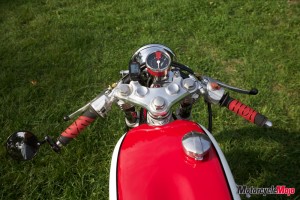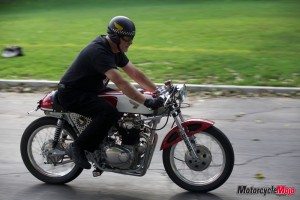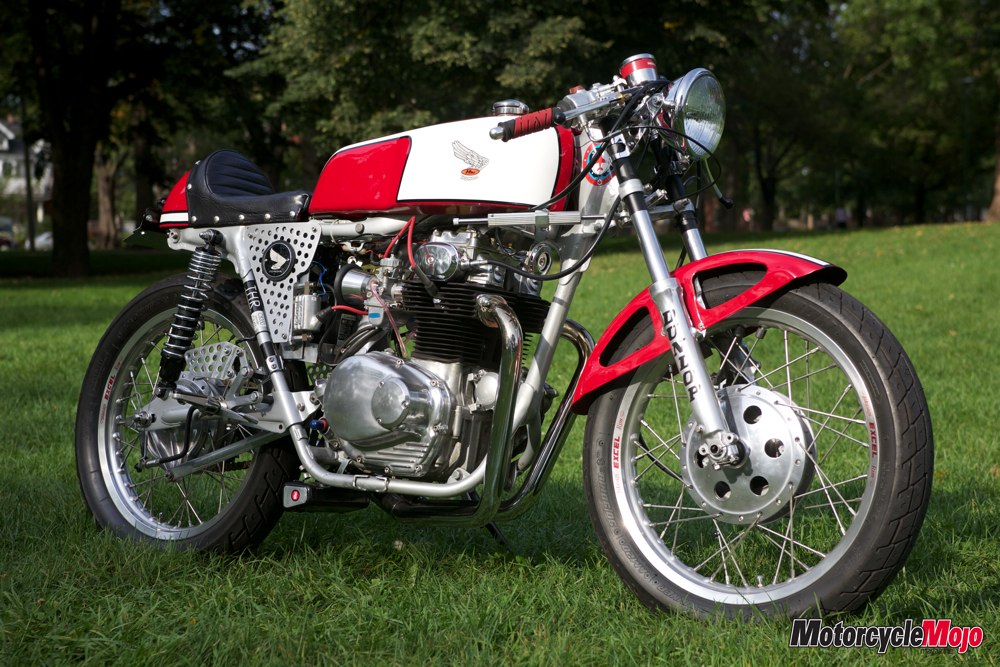The garage in Collingwood, Ontario, was damp and drafty, and the little CB350 vintage racer had been sitting neglected for more than a few seasons. The story was that the bike was built but never raced, and the light rust and oxidization begged for someone’s tender loving care. I was “tech support” along for the ride with my buddy, Ed, who was looking to buy.
We pushed it out into the cool fall sunshine and tried to fire it up. The carbs leaked badly, the battery was pooched, and after much pushing and cursing we only managed to get it running, briefly, on one cylinder. It was the classic diamond in the rough. Ed negotiated a deal and we loaded the tiny forlorn gem onto his truck. The initial rescue was a success; however, complete resuscitation would prove to be the greater challenge.
Ed spent many hours cleaning and detailing, and even treated it to a new battery and a fresh pair of Mikuni carbs. His game plan was to install lights and build it into a light minimalist café racer for the street. The problem was, he just could not get it to run properly.
Meanwhile, I had lusted after the little Honda from the first time I set eyes on it, but could not justify a sixth classic Honda in my tiny garage. Finally Ed got so frustrated he offered the bike to me for his cost and I succumbed to the inevitable. Fate had played its hand, and this particular bike was destined to be mine. I quickly sold my trusty Motogiro bike, a 1965 305 Superhawk, and immediately handed the cash over to Ed. It was a rather impulsive purchase. I had not ridden it, and it barely ran. With unknown internals and a largely uncertain past, it was a very bad gamble. Still, I just couldn’t resist. It was love at first sight, and it looked fabulous under the glowing lights of “Honda Heaven,” my little backyard workshop.
 My first challenge was sorting out the wiring. Ed had installed a compact chrome headlight and an LED taillight as well as an ignition switch, but I quickly determined that the battery was not charging while the bike was running. A few hours on the operating table with my trusty multi-meter, and all was well in the electrical department.
My first challenge was sorting out the wiring. Ed had installed a compact chrome headlight and an LED taillight as well as an ignition switch, but I quickly determined that the battery was not charging while the bike was running. A few hours on the operating table with my trusty multi-meter, and all was well in the electrical department.
Challenge number two was the carburetion. Despite many years of Honda restorations, I had very limited knowledge of Mikuni carbs, having worked mostly on stock Keihins. Add to this a total lack of base settings and no real knowledge of what internal modifications had been done to the engine, and I was truly groping in the dark. Fortunately, Ed had graciously supplied a full box of new spark plugs, so I fouled my way, eventually, to golden-brown electrode nirvana.
Once the bike was performing to my satisfaction, I added a few more of my own custom touches. I purchased a used chrome “chopper” tachometer at the Paris CVMG swap meet to replace the stock Honda unit for a tidier look. With nowhere to install the neutral light, I dug into my aviation archives and fished out a Boeing 727 galley oven light; problem solved. The lack of speedometer was remedied with a brilliant, family-sourced solution. My son, Spencer, is a bicycle tech at CyclePath in Toronto, and he suggested a Cateye wireless bicycle speedo. It was light, simple to install and surprisingly accurate.
 Who ever did the bulk of the initial work on this bike did a superb job. The aluminum race tank and paint are exquisite. Top-notch components were used throughout, including electronic ignition, Excel aluminum rims, stainless spokes, clip-ons, steering damper, rearsets and fresh Honda cables. Even the front brake drum was nicely cut out with cooling holes. Being a slightly anal retired aircraft mechanic, I spent an entire afternoon re-lock-wiring all the fasteners to an airworthy standard. It’s now a far cry from the garden variety 1972 CB350 that originally rolled off the Honda assembly line.
Who ever did the bulk of the initial work on this bike did a superb job. The aluminum race tank and paint are exquisite. Top-notch components were used throughout, including electronic ignition, Excel aluminum rims, stainless spokes, clip-ons, steering damper, rearsets and fresh Honda cables. Even the front brake drum was nicely cut out with cooling holes. Being a slightly anal retired aircraft mechanic, I spent an entire afternoon re-lock-wiring all the fasteners to an airworthy standard. It’s now a far cry from the garden variety 1972 CB350 that originally rolled off the Honda assembly line.
Now complete, the little Honda really goes. Based on some telltale signs, like titanium valve keepers and racing valve springs, visible through the valve adjust caps, and the way it pulls when the revs rise, it likely has a mild cam as well as other performance-enhancing engine work. The true test was when pal and ex-racer Steve Cannelos took it for a spin and gave it two thumbs up. High praise indeed for all my hard work and tuning persistence.
It may have a mysterious past with questionable racing pedigree, but it has a new home now, nestled in my tiny collection of classic Hondas. Impulse buys rarely prove prudent, but I’m glad I took the chance. With kudos to the original builder, this little rescued racer is a definite keeper.
| Owner: | Sam Longo |
| Make: | Honda |
| Model: | CB350 |
| Builder: | Unknown |
| Time to Build: | Unknown |
| Name of Bike: | Rescued Racer |
| Engine | |
| Year: | 1972 |
| Builder: | Unknown |
| Displacement: | 350 cc, high-compression pistons |
| Cases: | Original |
| Heads: | Mild cam, racing springs, titanium keepers |
| Lower End: | Original |
| Carburetor: | Twin Mikunis |
| Air Cleaner: | Screened velocity stacks |
| Ignition: | Electronic ignition |
| Exhaust: | Two into one |
| Transmission | |
| Year: | 1972 |
| Type: | 5-speed |
| Clutch: | Barnett |
| Primary Drive: | Chain |
| Frame | |
| Year: | 1972 |
| Type: | Original |
| Rake: | Stock |
| Shocks: | Works Performance |
| Modifications: | Tabs removed, painted silver, etc. |
| Front End | |
| Year: | 1972 |
| Type: | Original |
| Triple Trees: | Original |
| Modifications: | Clip-ons, progressive springs, drilled drum |
| Painting: | Unknown |
| Chroming: | Unknown |
| Restoration: | Detail and finishing work by Ed Liu and Sam Longo |
| Wheels | |
| Front Size: | 18-inch |
| Builder/Manufacturer | Excel aluminum rim/stainless spokes |
| Tire Make and size: | Dunlop 325×18 |
| Rear Size: | 18-inch |
| Builder/Manufacturer | Excel aluminum rim/stainless spokes |
| Tire Make and size: | Dunlop 350×18 |
| Essentials | |
| Gas Tank: | Aluminum custom made |
| Fenders: | Front fiberglass, rear none |
| Seat: | Custom-made fiberglass |
| Handlebars: | Clip-ons |
| Headlight: | Bates chrome mini |
| Taillight: | Custom LED |

































